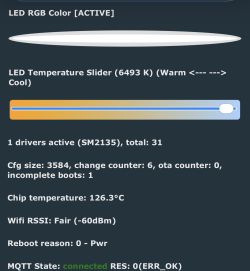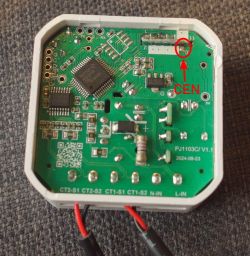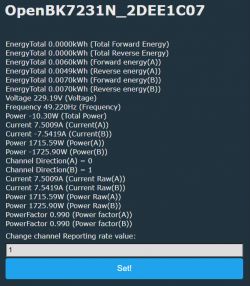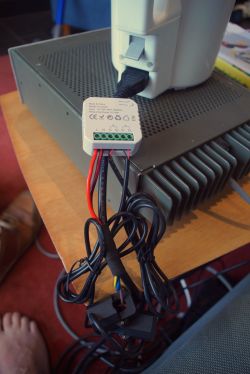>>21115933Thank you it works now, the command:
linkTuyaMCUOutputToChannel 106 1 10 0 10
linkTuyaMCUOutputToChannel 108 1 11 0 10
Czy wolisz polską wersję strony elektroda?
Nie, dziękuję Przekieruj mnie tam


startDriver TuyaMCU
tuyaMcu_setBaudRate 9600
tuyaMcu_defWiFiState 4
//Total energy forward
setChannelType 1 EnergyTotal_kWh_div1000
SetChannelLabel 1 "Total Forward Energy"
linkTuyaMCUOutputToChannel 1 1 1
//Total energy reverse
setChannelType 2 EnergyTotal_kWh_div1000
SetChannelLabel 2 "Total Reverse Energy"
linkTuyaMCUOutputToChannel 2 1 2
//power A
setChannelType 3 Power_div10
SetChannelLabel 3 "Power(A)"
linkTuyaMCUOutputToChannel 101 1 3
//Direction A
setChannelType 4 Raw
SetChannelLabel 4 "Direction(A)"
linkTuyaMCUOutputToChannel 102 1 4
//Direction B
setChannelType 5 Raw
SetChannelLabel 5 "Direction(B)"
linkTuyaMCUOutputToChannel 104 1 5
//power B
setChannelType 6 Power_div10
SetChannelLabel 6 "Power(B)"
linkTuyaMCUOutputToChannel 105 1 6
//forward energy A
setChannelType 7 EnergyTotal_kWh_div1000
SetChannelLabel 7 "Forward energy(A)"
linkTuyaMCUOutputToChannel 106 1 7
//reverse energy A
setChannelType 8 EnergyTotal_kWh_div1000
SetChannelLabel 8 "Reverse energy(A)"
linkTuyaMCUOutputToChannel 107 1 8
//forward energy B
setChannelType 9 EnergyTotal_kWh_div1000
SetChannelLabel 9 "Forward energy(B)"
linkTuyaMCUOutputToChannel 108 1 9
//reverse energy B
setChannelType 10 EnergyTotal_kWh_div1000
SetChannelLabel 10 "Reverse energy(B)"
linkTuyaMCUOutputToChannel 109 1 10
//power factor A
setChannelType 11 PowerFactor_div100
SetChannelLabel 11 "Power factor(A)"
linkTuyaMCUOutputToChannel 110 1 11
//frequency
setChannelType 12 Frequency_div100
SetChannelLabel 12 "Frequency"
linkTuyaMCUOutputToChannel 111 1 12
//voltage
setChannelType 13 Voltage_div10
SetChannelLabel 13 "Voltage"
linkTuyaMCUOutputToChannel 112 1 13
//current A
setChannelType 14 Current_div1000
SetChannelLabel 14 "Current(A)"
linkTuyaMCUOutputToChannel 113 1 14
//current B
setChannelType 15 Current_div1000
SetChannelLabel 15 "Current(B)"
linkTuyaMCUOutputToChannel 114 1 15
//total power
setChannelType 16 Power_div10
SetChannelLabel 16 "Total Power"
linkTuyaMCUOutputToChannel 115 1 16
//power factor B
setChannelType 17 PowerFactor_div100
SetChannelLabel 17 "Power factor(B)"
linkTuyaMCUOutputToChannel 121 1 17
//reporting rate
setChannelType 18 TextField
SetChannelPrivate 18 true
SetChannelLabel 18 "Reporting rate"
linkTuyaMCUOutputToChannel 129 val 18
addRepeatingEvent 10 1 SetChannel 18 3
// warning! pseudocode! take care!
// I assume that channel 12 is result
// channel 10 is sign
// channel 11 is unsigned val
alias positive setChannel 12 $CH11
alias negative setChannel 12 $CH11*-1
alias myset if $CH10==0 then positive else negative
// WARNING 2 - PSEUDOCODE, NOT TESTED, may have syntax errors
// now trigger it on every change
addEventHandler OnChannelChange 10 myset
addEventHandler OnChannelChange 11 myset
//power A
setChannelType 3 Power_div10
SetChannelLabel 3 "Power(A)"
linkTuyaMCUOutputToChannel 101 1 3
//Direction A
setChannelType 4 Raw
SetChannelLabel 4 "Direction(A)"
linkTuyaMCUOutputToChannel 102 1 4
//Corrected Power
setChannelType 19 Raw
SetChannelLabel 19 "Corrected Power(A)"
// warning! pseudocode! take care!
// I assume that channel 12 is result
// channel 10 is sign 4
// channel 11 is unsigned val 3
alias positive setChannel 19 $CH3
alias negative setChannel 19 $CH3*-1
alias myset if $CH4==0 then positive else negative
// WARNING 2 - PSEUDOCODE, NOT TESTED, may have syntax errors
// now trigger it on every change
addEventHandler OnChannelChange 3 myset
addEventHandler OnChannelChange 4 myset


startDriver TuyaMCU
//Total energy forward
setChannelType 1 EnergyTotal_kWh_div1000
SetChannelLabel 1 "Total Forward Energy"
linkTuyaMCUOutputToChannel 1 1 1
//Total energy reverse
setChannelType 2 EnergyTotal_kWh_div1000
SetChannelLabel 2 "Total Reverse Energy"
linkTuyaMCUOutputToChannel 2 1 2
//forward energy A
setChannelType 3 EnergyTotal_kWh_div1000
SetChannelLabel 3 "Forward energy(A)"
linkTuyaMCUOutputToChannel 106 1 3
//reverse energy A
setChannelType 4 EnergyTotal_kWh_div1000
SetChannelLabel 4 "Reverse energy(A)"
linkTuyaMCUOutputToChannel 107 1 4
//forward energy B
setChannelType 5 EnergyTotal_kWh_div1000
SetChannelLabel 5 "Forward energy(B)"
linkTuyaMCUOutputToChannel 108 1 5
//reverse energy B
setChannelType 6 EnergyTotal_kWh_div1000
SetChannelLabel 6 "Reverse energy(B)"
linkTuyaMCUOutputToChannel 109 1 6
//voltage
setChannelType 7 Voltage_div10
SetChannelLabel 7 "Voltage"
linkTuyaMCUOutputToChannel 112 1 7
//frequency
setChannelType 8 Frequency_div100
SetChannelLabel 8 "Frequency"
linkTuyaMCUOutputToChannel 111 1 8
//total power
setChannelType 9 Power_div10
SetChannelLabel 9 "Total Power"
linkTuyaMCUOutputToChannel 115 1 9
//current A
setChannelType 16 Current_div1000
SetChannelLabel 16 "Current Raw(A)"
linkTuyaMCUOutputToChannel 113 1 16
setChannelType 10 Current_div1000
SetChannelLabel 10 "Current(A)"
addEventHandler OnChannelChange 16 SetChannel 10 $CH16-(2*$CH14*$CH16)
//current B
setChannelType 17 Current_div1000
SetChannelLabel 17 "Current Raw(B)"
linkTuyaMCUOutputToChannel 114 1 17
setChannelType 11 Current_div1000
SetChannelLabel 11 "Current(B)"
addEventHandler OnChannelChange 17 SetChannel 11 $CH17-(2*$CH15*$CH17)
//power A
setChannelType 18 Power_div10
SetChannelLabel 18 "Power Raw(A)"
linkTuyaMCUOutputToChannel 101 1 18
setChannelType 12 Power_div10
SetChannelLabel 12 "Power(A)"
addEventHandler OnChannelChange 18 SetChannel 12 $CH18-(2*$CH14*$CH18)
//power B
setChannelType 19 Power_div10
SetChannelLabel 19 "Power Raw(B)"
linkTuyaMCUOutputToChannel 105 1 19
setChannelType 13 Power_div10
SetChannelLabel 13 "Power(B)"
addEventHandler OnChannelChange 19 SetChannel 13 $CH19-(2*$CH15*$CH19)
//Direction A
setChannelType 14 ReadOnly
SetChannelLabel 14 "Direction(A)"
linkTuyaMCUOutputToChannel 102 1 14
//Direction B
setChannelType 15 ReadOnly
SetChannelLabel 15 "Direction(B)"
linkTuyaMCUOutputToChannel 104 1 15
//power factor A
setChannelType 20 PowerFactor_div100
SetChannelLabel 20 "Power factor(A)"
linkTuyaMCUOutputToChannel 110 1 20
//power factor B
setChannelType 21 PowerFactor_div100
SetChannelLabel 21 "Power factor(B)"
linkTuyaMCUOutputToChannel 121 1 21
//reporting rate
setChannelType 30 TextField
SetChannelPrivate 30 true
SetChannelLabel 30 "Reporting rate"
linkTuyaMCUOutputToChannel 129 val 30
addRepeatingEvent 10 1 SetChannel 30 1

snkbrzmir4 wrote:alias positive setChannel 19 $CH3
alias negative setChannel 19 $CH3*-1
alias myset if $CH4==0 then positive else negative
// WARNING 2 - PSEUDOCODE, NOT TESTED, may have syntax errors
// now trigger it on every change
addEventHandler OnChannelChange 3 myset
addEventHandler OnChannelChange 4 myset
randomalias324 wrote:addEventHandler OnChannelChange 16 SetChannel 10 $CH16-(2*$CH14*$CH16)
uart:
id: uart_bus
# pin 7 TX1 I/O UART_TX1, which is used for transmitting user data and corresponds to P11 of the IC. Do not pull it up. By default, the MCU serial port should be in low-level or high-impedance state.
tx_pin: GPIO11
# pin 5 RX1 I/O UART_RX1, which is used for receiving user data and corresponds to P10 of the IC. Do not pull it up. By default, the MCU serial port should be in low-level or high-impedance state.
rx_pin: GPIO10
baud_rate: 9600
tuya:
sensor:
# --- Total Energy Forward ---
- platform: tuya
name: "Total Forward Energy"
id: energy_total_fwd
sensor_datapoint: 1
unit_of_measurement: "kWh"
accuracy_decimals: 3
filters:
- multiply: 0.001
state_class: "total_increasing" # Marks it as a total increasing sensor for Home Assistant
device_class: "energy" # Marks it as an energy sensor for Home Assistant
# --- Total Reverse Energy ---
- platform: tuya
name: "Total Reverse Energy"
id: energy_total_rev
sensor_datapoint: 2
unit_of_measurement: "kWh"
accuracy_decimals: 3
filters:
- multiply: 0.001
state_class: "total_increasing" # Marks it as a total increasing sensor for Home Assistant
device_class: "energy" # Marks it as an energy sensor for Home Assistant
# --- Voltage ---
- platform: tuya
name: "Voltage"
id: voltage
sensor_datapoint: 112
unit_of_measurement: "V"
accuracy_decimals: 1
filters:
- multiply: 0.1
# --- Frequency ---
- platform: tuya
name: "Frequency"
id: frequency
sensor_datapoint: 111
unit_of_measurement: "Hz"
accuracy_decimals: 2
filters:
- multiply: 0.01
# --- Total Power ---
- platform: tuya
name: "Total Power"
id: power_total
sensor_datapoint: 115
unit_of_measurement: "W"
accuracy_decimals: 1
filters:
- multiply: 0.1
# --- Current (Phase A) ---
- platform: tuya
name: "Current(A)"
id: current_a
sensor_datapoint: 113
unit_of_measurement: "A"
accuracy_decimals: 3
filters:
- multiply: 0.001
# --- Current (Phase B) ---
- platform: tuya
name: "Current(B)"
id: current_b
sensor_datapoint: 114
unit_of_measurement: "A"
accuracy_decimals: 3
filters:
- multiply: 0.001
# --- Power (Phase A) ---
- platform: tuya
name: "Power(A)"
id: power_a
sensor_datapoint: 101
unit_of_measurement: "W"
accuracy_decimals: 1
filters:
- multiply: 0.1
# --- Power (Phase B) ---
- platform: tuya
name: "Power(B)"
id: power_b
sensor_datapoint: 105
unit_of_measurement: "W"
accuracy_decimals: 1
filters:
- multiply: 0.1
# --- Power Factor (Phase A) ---
- platform: tuya
name: "Power Factor(A)"
id: power_factor_a
sensor_datapoint: 110
accuracy_decimals: 2
filters:
- multiply: 0.01
# --- Power Factor (Phase B) ---
- platform: tuya
name: "Power Factor(B)"
id: power_factor_b
sensor_datapoint: 121
accuracy_decimals: 2
filters:
- multiply: 0.01
# --- WiFi Signal Strength ---
- platform: wifi_signal
name: "WiFi Signal"
update_interval: 60s
id: wifi_strength
unit_of_measurement: "dBm"
# --- Uptime ---
- platform: uptime
name: "Uptime"
id: uptime_sensor
update_interval: 60s
text_sensor:
- platform: tuya
name: "Reporting Rate"
id: reporting_rate
sensor_datapoint: 129
# --- WiFi IP Address ---
- platform: wifi_info
ip_address:
name: "Device IP"



